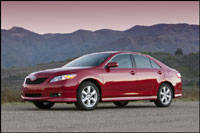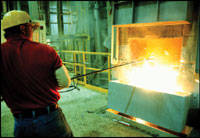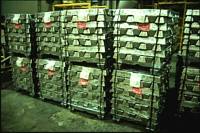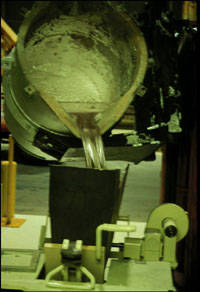Can General Motors and Ford Keep Up?There are two ways to increase your income; 1) spend less or 2)
 |
| How do you cut profits, without cutting quality, or dulling the 'cutting edge'? (Photo: Toyota Canada) |
make more. While no one questions whether or not Toyota Motor Company will have any problem achieving the second, the automaker is already a tightly run ship. Nevertheless, about 300 of its most creative engineers have figured out how to cut build costs of its popular 3.5-litre engine, by a significant margin.
How much is significant? Most bean-counters would be thrilled if their production departments managed to trim the cost of fabricating a single item by one or two percent, especially when dealing with such high volumes that a mere fraction of a percent could present a major difference to the bottom line. Such small increments of efficiency gains wouldn't be good enough
 |
| It's a beautiful thing when engineers and workers collaborate. (Photo: Toyota Canada) |
for Toyota's Executive Vice President Kosuke Shiramizu, mind you, who announced a new goal of reducing production costs by 50 percent to foundry workers at the Bodine Aluminum Troy, Missouri engine facility back in 2003.
What Shiramizu didn't say to his Troy workers was that they'd be getting a great deal of support in meeting these goals, from 300 engineers back in Toyota's Japanese R&D facilities. A new technology was being developed for pouring molten aluminum into molds for engine components, resulting in new equipment that made up Toyota's new
 |
| New efficiencies will help to reduce inventories of unfinished cylinder heads, expensive to store and, wasteful. (Photo: Toyota Canada) |
cost-cutting program dubbed Simple Slim. Basically, Simple Slim lets Toyota use smaller, cheaper molds to produce engine parts, and the system was easily implemented into its U.S. foundries as well as those in Japan and China. Another reason the new engine is cheaper to produce is that it uses less aluminum, an expensive metal, than the current version. The new aluminum block weighs 25 kilograms (55 pounds) less than the 3.3-litre engine, a 27 percent reduction in overall mass. Another improvement to the new 3.5 includes a redesigned cylinder head that needs fewer honeycomb-like fuel and air passageways.
The new engine design is also allowing for smaller caster machines at
 |
| Toyota's technology can be applied to engine plants in China and Japan. (Photo: Toyota Canada) |
the foundries, again reducing costs. New efficiencies will help to reduce inventories of unfinished cylinder heads, expensive to store and, wasteful. Also, defects will be easier to spot with the new process, potentially allowing Toyota's V6 to once again rise to the highest levels of reliability - it suffered some setbacks with its previous V6.
To put this in perspective, Toyota's Jackson, Tennessee engine block factory, which has been using similar casting methods since it opened in November, has reported an extremely low 0.7 percent defect rate in its engine blocks. This compares with a 2 percent defect rate at Troy, which is similar to Toyota's Japanese foundries that use the old casting methods.
Another effort sees savings from reducing the number of clamps needed to hold the cylinder heads in place while it's being machined by 80 percent. The new process reduces machining costs by a staggering 50 percent. Also, Toyota's Georgetown plant has halved the length of its V6 assembly line by moving "just in time" kit boxes of parts along the line with each engine.






